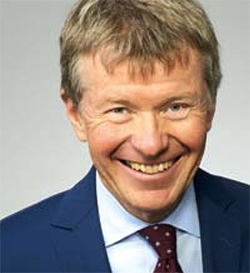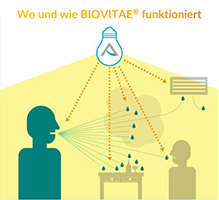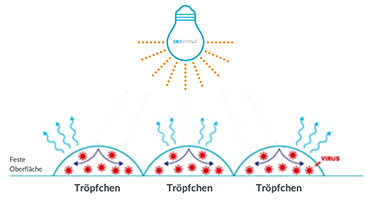Biovitae combines LED lighting and safe surface disinfection –
Instead of UV-C-based disinfection, Nextsense and Aurora Lichtwerke rely on microbicidal LED lighting that emits natural soft light and disinfects surfaces, but is completely harmless to living beings. Thomas Walentowski from the Light & Disinfection department at Aurora explains how this works.

“Even when the SARS-CoV-2 pandemic is over, we expect demand to remain high, especially since Biovitae, unlike other technologies, is also effective against multi-resistant bacteria and viruses.”
Thomas Walentowski, Aurora Lichtwerke
Markt&Technik: Mr Walentowski, you describe the Biovitae technology as unique. What makes it so special?
Thomas Walentowski: The patented Biovitae technology with the dual lighting and disinfection function uses the blue-violet spectrum of visible light, reducing germs, bacteria, viruses, fungi and spores whenever the light is switched on – and is completely safe for any people and animals in the rooms.
Some of your competitors also claim their products can be operated safely around people and animals. What’s the difference?
Biovitae works with the combination of different wavelengths of blue-violet light – 400 to 420 nanometres – with soft light, i.e. in the visible range of the electromagnetic spectrum, and meets the highest photobiological safety level according to IEC 62471. This has already been certified by TÜV and the effectiveness against germs has been confirmed by several independent scientific institutions, including the Bundeswehr Institute of Microbiology in Munich. UV-C radiation, on the other hand, is not visible and works with significantly shorter wavelengths – normally 254 nm – which are very dangerous for humans and animals and cause severe damage, especially to the skin and eyes, in the event of direct exposure, depending on the radiation dose, of course.
That is why almost all UV-C disinfection devices available on the market work with disinfection chambers or disinfection channels that are hermetically sealed from the environment. On the other hand, the open use of UV-C radiation – even with higher room heights – is very controversial. Biovitae household bulbs are also absolutely safe for use at home, in contrast to UV-C disinfection bulbs with timers and motion sensors. If, for example, someone falls asleep under Biovitae light while watching TV in the evening, it is completely harmless; with the UV-C lamp, on the other hand, this can be very dangerous if the motion sensor does not respond due to lack of movement and the UV-C lamp therefore does not switch off; the slumbering television viewer would wake up with burned skin. The way Biovitae works is also fundamentally different from UV-C radiation: Biovitae destroys the cell wall of the micro-organisms, killing them instantly, which means that no resistance can develop. UV-C radiation attacks the DNA/RNA of the viruses and prevents them from multiplying; in some cases, however, viruses are able to repair this damage, which can lead to the creation of new, more resistant variants.

Functional principle of Biovitae technology
What were the biggest challenges during development?
Researching the correct and patented combination of blue-violet light and launching the Biovitae technology on the market relatively quickly despite the complex studies. Only the combination of different wavelengths and intensities in the wavelength range between 400 and 420 nm in combination with soft light leads to efficient germ reduction with regard to most bacteria, viruses, fungi and spores. If only one wavelength were used, for example 405 nm, the effective spectrum would be considerably smaller.


The germ-reducing effect is part of the lighting
The Biovitae technology itself was invented by the Italian company Nextsense, the LED tubes equipped with it come from you and your partner Seaborough. How are the competencies and tasks distributed in this three-way partnership?
Nextsense covers the medical, bacteriological and virological research and development area, Seaborough brings the electronics know-how for the specific LED drivers of the tubes to ensure compatibility with over 98 percent of the lights on the market. And last but not least, Aurora Lichtwerke, as the former Eichstätt plant of Osram, provides the experience of several decades of general development in the lighting industry, in bulb and light construction and in measurement and testing technology.
In addition to the Biovitae technology, your system is based on another patent, the oneTLed technology by Seaborough, which means that the light source fits into any existing light. How important was this universal retrofit approach for the new products?
From decades of experience in the lighting industry, we know how immensely important, yet difficult it is to make LED retrofit tubes compatible with existing lights. These existing lights, originally designed for mercury-containing and thus toxic fluorescent bulbs, are equipped with a wide variety of electronic ballasts. The success of an environmentally friendly LED retrofit solution for these lights therefore depends crucially on the LED tube harmonising perfectly with all of these different systems. That’s why we chose Seaborough’s oneTLed technology.
Where do you see the greatest market potential for your products? And are you aiming for purely B2B or will Aurosun LEDs also be available for private use?
We see market potential in a great many areas. In the B2B environment, anywhere that large numbers of people congregate. These can be very different areas such as hospitals, medical practices, public authorities, schools, kindergartens, hairdressers, shops, department stores, hotels, cruise ships and restaurants, as well as specific areas in buildings that are particularly contaminated with germs, such as elevators and sanitary areas. In addition, we will also soon be offering Biovitae technology for private use, for example in the form of the tried-and-tested household bulb with the E-27 screw base.
From a regional perspective, which parts of the world are showing the greatest interest in Biovitae technology?
Our business focus is currently on the German-speaking region and neighbouring European countries.
How do you expect demand for disinfection products like yours to develop after the Covid-19 pandemic?
We do not see any need to link efficient germ reduction that is harmless to humans solely with the SARS-CoV-2 pandemic. This means, even after the pandemic is over, we’re still expecting high levels of demand, especially since Biovitae, unlike other technologies, is also effective against multi-resistant bacteria and viruses.
The interview was conducted by Nicole Wörner.